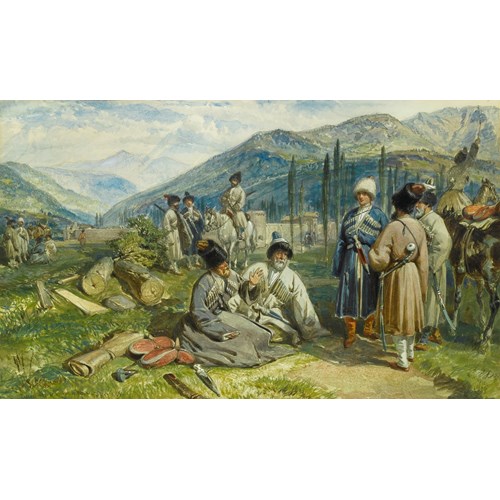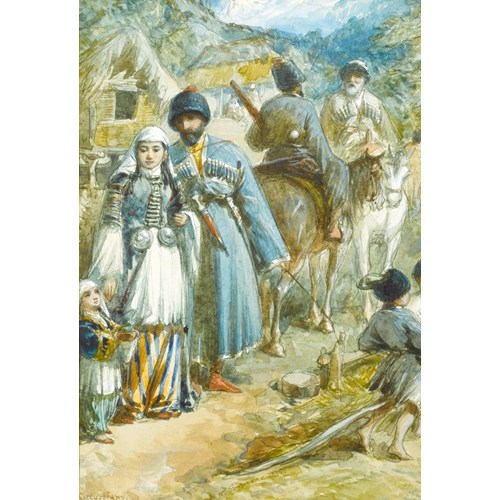Marketplace
A Desert Fort
Aleksandr Evgen'evich Yakovlev
A Desert Fort
Epoque 20th century
Origine Russia, France
Medium Red chalk on paper
Dimension 46.3 x 61.6 cm (18¹/₄ x 24¹/₄ inches)
Aleksandr Evgen'evich Yakovlev’s A Desert Fort demonstrates his brilliance as a draughtsman. By exploiting the grain of the paper with just red chalk, he manages to create a variety of textures. From the whipped-up sand dunes with their spiky dry grasses, and the wispy clouds, to the heavy shadows created by this ancient fort, or qala, Yakovlev cleverly evokes the barren landscape of Karakalpakstan.
Karakalpakstan is a remote isolated area, surrounded by desert sands in every direction. To the east, the sands of the Qizil Qum stretch as far as Bukhara. To the south, the empty Qara Qum desert reaches the foothills of the Kopet Dag and Ashgabat. To the west, the barren rocky plateau of the U'stirt extends to the shores of the Caspian Sea. To the north, an enormous barren landscape of desert and salty lakes eventually merges into the Russian steppes and the frontier towns of Orenburg and Samara.
Despite its desolate landscape, Karakalpakstan contains the largest number of important archaeological sites relating to the ancient civilization of Khorezm. During the second half of the first millennium B.C., and the first half of the first millennium A.D., the whole region was a thriving agricultural oasis, supported by a huge network of man-made irrigation channels. Its population believed in the Zoroastrian cult of fire. They were governed by a dynasty of Khorezmshahs who lived in richly decorated palaces and they were defended from nomadic attack by an elaborate system of garrisons stationed in sophisticated mud-brick fortresses with an advanced military design.
The remnants of several of these citadels, fortresses, castles and other sites, known as qalas, many of which date back almost two thousand years, still exist today. The number of existing qalas in Karakalpakstan, many of which are un-named, is unknown, but is believed to be in the hundreds. However, many smaller forts were destroyed and ploughed over during the agricultural development of the 1960s and 1970s. By comparing photographs from Sergei Tolstov’s Khorezm archaeological expedition of the late 1930s, one can also note the considerable and devastating erosion which many of the remaining qalas have suffered over the last sixty years. Much of this erosion was as a result of archaeological works being left uncovered, and it is plausible that the fort depicted by Yakovlev no longer exists.
From information taken from Tolstov’s expedition one can see similarities between some of the sites and the fort depicted by Yakovlev. One such example is the site known as Ayaz Qala 2, which like Yakovlev’s fort was built on an elevated plateau. Part of a group of three qalas, Ayaz Qala 2 is a feudal fort probably dating from the 6th to the 8th centuries A.D. During this period, as Khorezm expanded and grew prosperous, a new class of feudal landowners emerged. Known as dihqans, they lived in square-shaped forts called donjons surrounded by a defensive wall, generally located at the head of the canal that watered their agricultural lands.
Yakovlev’s desert fort, possibly also a feudal fort, was probably built with blocks of compacted clay or mud, as was typical of qalas. By solely employing the use of red chalk, Yakovlev emphasises the composition of the fort’s structure. Yakovlev’s fort boasts crenulations on its outside walls, some of which are rounded, recalling the walls of Bukhara. Two tall rectangular towers dominate the perimeter wall, and although this is not visible from the present angle, Yakovlev’s fort was probably accessed via a single fortified entrance. A single row of arrow slits runs around the entire perimeter, which in addition to the crenelated parapet, provided a double archer’s gallery.
Karakalpakstan is a remote isolated area, surrounded by desert sands in every direction. To the east, the sands of the Qizil Qum stretch as far as Bukhara. To the south, the empty Qara Qum desert reaches the foothills of the Kopet Dag and Ashgabat. To the west, the barren rocky plateau of the U'stirt extends to the shores of the Caspian Sea. To the north, an enormous barren landscape of desert and salty lakes eventually merges into the Russian steppes and the frontier towns of Orenburg and Samara.
Despite its desolate landscape, Karakalpakstan contains the largest number of important archaeological sites relating to the ancient civilization of Khorezm. During the second half of the first millennium B.C., and the first half of the first millennium A.D., the whole region was a thriving agricultural oasis, supported by a huge network of man-made irrigation channels. Its population believed in the Zoroastrian cult of fire. They were governed by a dynasty of Khorezmshahs who lived in richly decorated palaces and they were defended from nomadic attack by an elaborate system of garrisons stationed in sophisticated mud-brick fortresses with an advanced military design.
The remnants of several of these citadels, fortresses, castles and other sites, known as qalas, many of which date back almost two thousand years, still exist today. The number of existing qalas in Karakalpakstan, many of which are un-named, is unknown, but is believed to be in the hundreds. However, many smaller forts were destroyed and ploughed over during the agricultural development of the 1960s and 1970s. By comparing photographs from Sergei Tolstov’s Khorezm archaeological expedition of the late 1930s, one can also note the considerable and devastating erosion which many of the remaining qalas have suffered over the last sixty years. Much of this erosion was as a result of archaeological works being left uncovered, and it is plausible that the fort depicted by Yakovlev no longer exists.
From information taken from Tolstov’s expedition one can see similarities between some of the sites and the fort depicted by Yakovlev. One such example is the site known as Ayaz Qala 2, which like Yakovlev’s fort was built on an elevated plateau. Part of a group of three qalas, Ayaz Qala 2 is a feudal fort probably dating from the 6th to the 8th centuries A.D. During this period, as Khorezm expanded and grew prosperous, a new class of feudal landowners emerged. Known as dihqans, they lived in square-shaped forts called donjons surrounded by a defensive wall, generally located at the head of the canal that watered their agricultural lands.
Yakovlev’s desert fort, possibly also a feudal fort, was probably built with blocks of compacted clay or mud, as was typical of qalas. By solely employing the use of red chalk, Yakovlev emphasises the composition of the fort’s structure. Yakovlev’s fort boasts crenulations on its outside walls, some of which are rounded, recalling the walls of Bukhara. Two tall rectangular towers dominate the perimeter wall, and although this is not visible from the present angle, Yakovlev’s fort was probably accessed via a single fortified entrance. A single row of arrow slits runs around the entire perimeter, which in addition to the crenelated parapet, provided a double archer’s gallery.
Epoque: 20th century
Origine: Russia, France
Medium: Red chalk on paper
Signature: Signed in Cyrillic (lower right)
Dimension: 46.3 x 61.6 cm (18¹/₄ x 24¹/₄ inches)
Plus d'œuvres d'art de la Galerie







-Baumgartner-Stoiloff-Running from the Wolves_T637903807484877285.jpg?width=500&height=500&mode=pad&scale=both&qlt=90&format=jpg)

